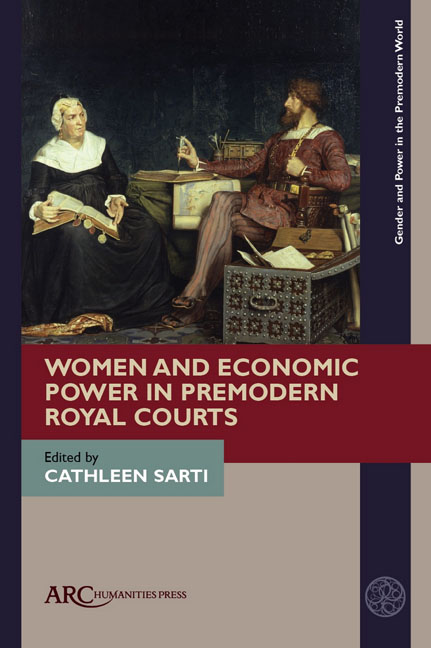Book contents
- Frontmatter
- Contents
- Acknowledgements
- Introduction: Women and Economic Power in Premodern Royal Courts
- 1 The Medieval English Queen as Landholder: Some Reflections on Sources and Methodology
- 2 Financial Power of Empresses and Princess Consorts of the Holy Roman Empire
- 3 “Edward III’s Gold-Digging Mistress”: Alice Perrers, Gender, and Financial Power at the English Royal Court, 1360– 1377
- 4 Counselling the Danish King: Sigbrit Villoms as Financial Mastermind for Christian II, 1513– 1523
- Afterword: “Power Is Money”? Reflections on Money, Power, Sex, and Gender in Premodern Royal Courts
- Bibliography
- Index of Persons and Topics
Introduction: Women and Economic Power in Premodern Royal Courts
Published online by Cambridge University Press: 20 November 2020
- Frontmatter
- Contents
- Acknowledgements
- Introduction: Women and Economic Power in Premodern Royal Courts
- 1 The Medieval English Queen as Landholder: Some Reflections on Sources and Methodology
- 2 Financial Power of Empresses and Princess Consorts of the Holy Roman Empire
- 3 “Edward III’s Gold-Digging Mistress”: Alice Perrers, Gender, and Financial Power at the English Royal Court, 1360– 1377
- 4 Counselling the Danish King: Sigbrit Villoms as Financial Mastermind for Christian II, 1513– 1523
- Afterword: “Power Is Money”? Reflections on Money, Power, Sex, and Gender in Premodern Royal Courts
- Bibliography
- Index of Persons and Topics
Summary
THINKING ABOUT POWER means thinking about resources. Not only knowledge is power; money and material resources are power as well, and often in much more obvious ways. This is all the more important as recent research in the cultural history of politics has emphasized the impact and significance of representing power to a wider audience. Obviously, a ruler who wants to show off needs resources.
Where did premodern rulers receive their resources from, how were these resources managed, and how were control over resources and political influence interrelated and dependent upon one another? The hypothesis presented in this book suggests that women were often key figures in acquiring resources and managing them, for themselves as well as for their (royal) families and their courts. Moreover, the contributions in this volume put forward the idea that women at royal courts could use resources and skills to wield political influence, even though this influence was often challenged. Trying to reconstruct and understand the influence of women challenges the modern historian in turn due to the long tradition of excluding women from sources and research, as this volume's chapters likewise show.
This edited volume discusses the political power that women at premodern royal courts held through economic influence, resources, and skills. The nexus between economic and financial resources and skills on one hand and power and influence on the other is hardly new, and has already been studied for premodern times as well as for premodern women. Nevertheless, research hitherto has neglected to analyze this nexus specifically for the royal court— the space of political, social, religious, and cultural power in premodern societies. In addition to its explicit analysis of royal courts, this book offers a specific gender perspective, focusing on women and their agency, their reliance on marriages and families, and the difficulties involved in overcoming the biased source and research material. By adopting this perspective, the authors of this volume aim to continue a current conversation about women's economic resources and skills and about how women used these resources to gain political power; in so doing, we challenge hitherto dominant narratives of women's dependence on their spouses. Furthermore, we critically assess how much political influence their economic and financial resources yielded, and how any potential premodern “glass ceilings” worked. Finally, we understand this book as a contribution to the ongoing debate on the economics of monarchies, courts, and dynasties.
- Type
- Chapter
- Information
- Publisher: Amsterdam University PressPrint publication year: 2020

